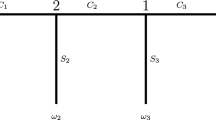Abstract
Equivalence classes of normal form games are defined using the discontinuities of correspondences of standard equilibrium concepts like correlated, Nash, and robust equilibrium, or risk dominance and rationalizability. Resulting equivalence classes are fully characterized and compared across different equilibrium concepts for 2 × 2 games; larger games are also studied. It is argued that the procedure leads to broad and game-theoretically meaningful distinctions of games as well as to alternative ways of representing, comparing and testing equilibrium concepts.
Similar content being viewed by others
References
Bárány I, Lee J, Shubik M (1992) Classification of two-person ordinal bimatrix games. Int J Game Theory 21:267–290
Berlekamp ER, Conway JH, Guy RK (2003) Winning ways for your mathematical plays, I–IV, 2nd ed. A.K. Peters, San Jose, CA
Blume LE, Zame WR (1994) The algebraic geometry of perfect and sequential equilibrium. Econometrica 62:783–794
Bochnak J, Coste M, Roy MF (1998) Real algebraic geometry. Springer, Berlin Heidelberg New York
Carlsson H, van Damme E (1993) Global games and Equilibrium Selection. Econometrica, 61: 989–1018
Conway JH (2001) On numbers and games, 2nd ed. A.K. Peters, San Jose, CA
Coste M (2002) An introduction to semialgebraic Geometry. Mimeo, Université de Rennes
Crawford VP (1997) Theory and experiment in the analysis of strategic interaction. In Kreps DM, Wallis KF (eds), Advances in economics and econometrics: Theory and applications, I, Seventh World congress of the econometric Society. Cambridge University Press, Cambridge
Erev I, Roth AE (1998) Modeling how people play games: reinforcement learning in experimental games with unique mixed strategy equilibria. Amer Econ Rev 88:848–881
Fudenberg D, Tirole J (1991) Game Theory. MIT Press, Cambrgidge, MA
Germano F (1998) On Nash equivalence classes of generic normal form games. CORE Discussion Paper No. 9833
Harsanyi J, Selten R (1988) A general theory of equilibrium selection in games. MIT Press, Cambridge, MA
Hart S, Mas-Colell A (2003) Regret-based continuous-time dynamics. Games Econ Behav 45: 375–394
Kajii A, Morris S (1997a) The robustness of equilibria to incomplete information. Econometrica 65:1283–1309
Kajii A, Morris S (1997b) Refinements and higher order beliefs: A unified survey. Mimeo, Yale University
McKelvey RD, McLennan A (1997) The maximal number of regular totally mixed Nash equilibria. J Econ Theory. 72:411–425
Mertens J-F (2004) Ordinality in non-cooperative games. Int J Game Theory 32:387–430
Morris S, Rob R, Shin HS (1995) p-Dominance and belief potential. Econometrica 63:145–157
Morris S, Shin HS (2003) Global games: theory and applications. In: Dewatripont M, Hansen LP, Turnovsky SJ (eds), Advances in economics and econometrics: Theory and applications, Eighth World congress of the econometric society. Cambridge University Press, Cambridge
Morris S, Ui T (2004) Best response equivalence. Games Econ Behav 49:260–287
Myerson RB (1991) Game theory. Harvard University Press, Cambridge, MA
Nash J (1951) Non-cooperative games. Ann Math 54:286–295
Nemhauser GL, Wolsey LA (1988) Integer and combinatorial optimization. Wiley, New York
Ochs J (1995) Coordination Problems. In: Kagel JH, Roth AE (eds), Handbook of experimental economics. Princeton University Press, Princeton, NJ
Pearce DG (1984) Rationalizable strategic Behavior and the problem of perfection. Econometrica 52:1029–1050
Rapoport A, Guyer MJ (1966) A taxonomy of 2 × 2 games. General Syst 11:203–214
Rapoport A, Guyer MJ Gordon DG (1976) The 2 × 2 game. University of Michigan Press, Ann Arbor
Roth AE (1995) Introduction to experimental economics. In: Kagel JH, Roth AE (eds), Handbook of experimental economics. Princeton University Press, Princeton, NJ
Schanuel SH, Simon LK, Zame WR (1991) The algebraic geometry of games and the tracing procedure. In: Selten R (ed), Game equilibrium models, II: Methods, morals, and markets. Springer, Berlin Heidelberg New York
Van Damme E (1991) Stability and perfection of Nash equilibria, 2nd ed. Springer, Berlin Heidelberg New york
Van Damme E (2002) Strategic Equilibrium. In: Aumann R, Hart S (eds), Handbook of game theory, III. Elsevier, Amsterdam
Von Stengel B (2002) Computing equilibria for two-person games. In: Aumann R, Hart S (eds), Handbook of game theory, III. Elsevier, Amsterdam
Author information
Authors and Affiliations
Corresponding author
Rights and permissions
About this article
Cite this article
Germano, F. On some geometry and equivalence classes of normal form games. Int J Game Theory 34, 561–581 (2006). https://doi.org/10.1007/s00182-006-0033-6
Accepted:
Published:
Issue Date:
DOI: https://doi.org/10.1007/s00182-006-0033-6



